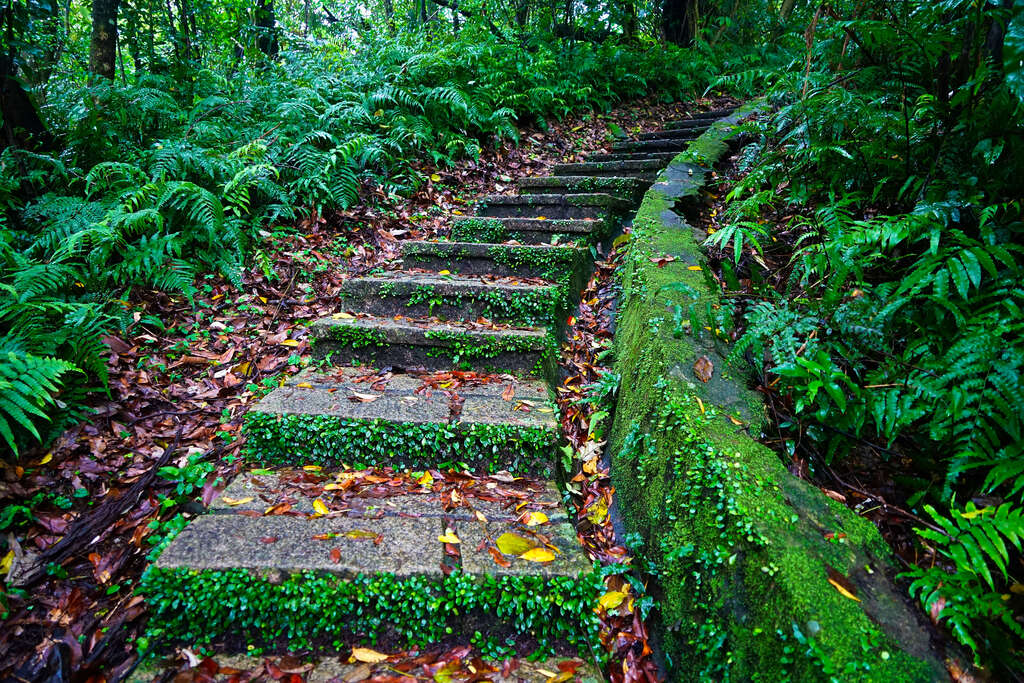Nankang Mountain Range - Gengliao Ancient Trail Introduction
Gengliao Ancient Trail is the most well-preserved and still-used ancient path among the five ancient trails connecting Nangang to ShenKeng and Shiding in earlier times. This trail is not only a shortcut to Shanjiu Cave and Tukuyue, but also a century-old road for exploring ancient house relics. The path is now paved with granite steps, yet the narrow starting and ending sections still showcase the ruggedness of its ancient form. Parts of the unpaved gravel sections are adorned with little white flowers, highlighting the trail's rustic charm. The latter section of Gengliao Ancient Trail connects to Laoliao Trail, which used to be a tea-growing area with a dense presence of tea shops. Historically, the trail was known as Naoliao Ancient Trail because it was a site for transporting and processing camphor. About 110 years ago, it became the most frequented route for tea merchants and villagers and was later renamed Laoliao, phonetically similar. The name Gengliao Ancient Trail was derived from its use by patrollers during the Qing Dynasty. Once a thriving path for ancestors, it has now faded into a serene hiking route. Chun-Hsuan Farm, originally known as Nangang First Citizen Farm, has been transformed into a comprehensive farm that combines educational and recreational functions, cultivating over a thousand fragrant Yushen trees, daylilies, and osmanthus trees, alongside treehouses and viewing platforms for visitors to enjoy the scenery. Wanggaoliao, located at the highest point of Tukuyue, offers views of Greater Taipei City and serves as a military fortification. Legend has it that a observation tower was established here during the Qing Dynasty, guarded by armed patrollers. The structure built today provides even better and wider views, justifying its name, Wanggaoliao. Along the Gengliao Trail, one can often see the bustling scenery of National Highway No. 5, and nearby are several century-old buildings, including the "Pan Ancestor House," which has a history of 160 years. This structure serves as a testament to the legacy left by early settlers, with ancient gun holes remaining on its exterior. The descendants of the Pan family have lived here for eight generations, becoming witnesses to this history. The five ancient trails from Nangang to ShenKeng and Shiding today only have Gengliao Ancient Trail preserved intact and still in use. It is not only an essential route to Shanjiu Cave or climbing Tukuyue but also holds many "ancient treasures." Even though granite steps have been laid along the trail, the narrow stone steps at the starting point can only accommodate one person, evoking a sense of the past. Climbing to the hillside, behind a pavilion, is the "Huang Wang Old Residence," a stone house with 70 years of history that remains with relics of ancient tea-making machinery. The uphill path is nearly complete, with weeds alongside making one feel as if entering a "wrong path," until stepping onto the gravel path that crunches underfoot, lined with flowers similar to little daylilies on both sides. The short 300-meter journey is easy but remains most memorable. At the beginning of Gengliao Trail, the next ancient house still retains bullet holes and is the only century-old house in Nangang that is still inhabited, known as "Pan's Gun Hole House." The Pan family's descendants have lived here for eight generations, meaning the house is at least 160 years old, just like the ancient trail, enduring through ages. On the way to Laoliao Ancient Trail, the limestone quarry is a relic developed by early ancestors; the site of Wei Jing-chi's former residence, even in its ruin, flows with a sense of pass and is an inspiration of the past prosperity of the tea mountain. Along the way, the earth buildings, Zheng family cemetery, and the "mini" land god temple, only 30 centimeters tall, all testify to the century-old history of the ancient trail. The tea legacy in these mountains can be traced back to more than 200 years ago during the Qianlong period of the Qing Dynasty, when this area was a significant production site for camphor and tea exports in early Taiwan. The "Wenshan Pao-zhong tea" developed by Wang Shuijun and the "Nangang Pao-zhong tea" created a golden age for Nangang tea, which gained fame and even reached Southeast Asia, with some old tea houses in Thailand still using the Nangang name to attract customers. 110 years ago, Laoliao Ancient Trail was a busy tea road used by merchants and villagers; tracing back to its origins, it used to be a camphor collecting and processing route, hence it was originally named Naoliao Ancient Trail. The name "Laoliao" was later changed due to its phonetic similarity. Gengliao Ancient Trail obtained its name as it served as a patroller's inspection road during the Qing Dynasty. During the Japanese occupation, it turned into a transportation route for tea merchants traveling between ShenKeng and Nangang; now, it has shed its former luster to become a hiking path for everyone seeking tranquility and nature. Gengliao Printing Pavilion: After walking for about five to six minutes along the narrow stone steps at the entrance of the trail, look to the right to see the Suhua Highway carved through the mountains, which passes beneath the Tukuyue, Shanjiu Cave Peak, and Gengliao Ancient Trail toward Shiding and Pinglin. Standing here, one can amusingly admire today's traffic, contrasting with the contact routes of the past. On sunny days, while heading toward Shanjiu Cave, standing on the steps allows a view back toward the Grand Hotel, Songshan Airport, Dazhi, and the Neihu Incinerator, taking in the panorama of the Taipei basin. As you ascend toward the mountain's peak, the scenery becomes richer, with the complete forest landscape and ecological plants nearby. Just before reaching the summit, there is a rare grove of pencil cedar trees resembling a tropical rainforest, and the gentle sound of the mountain stream washes away the fatigue accumulated along the steep slope.





















